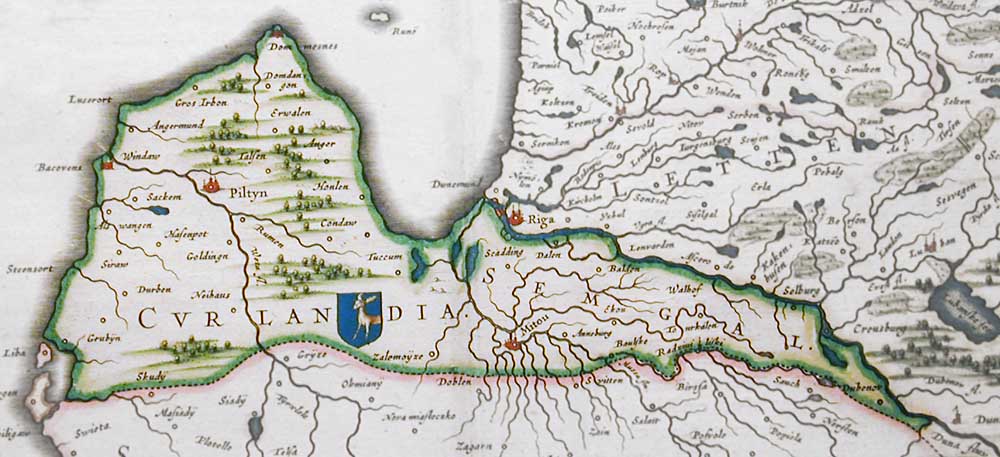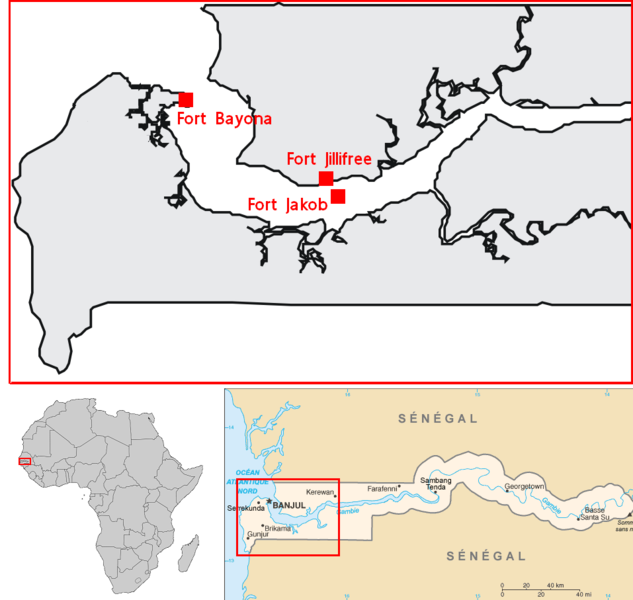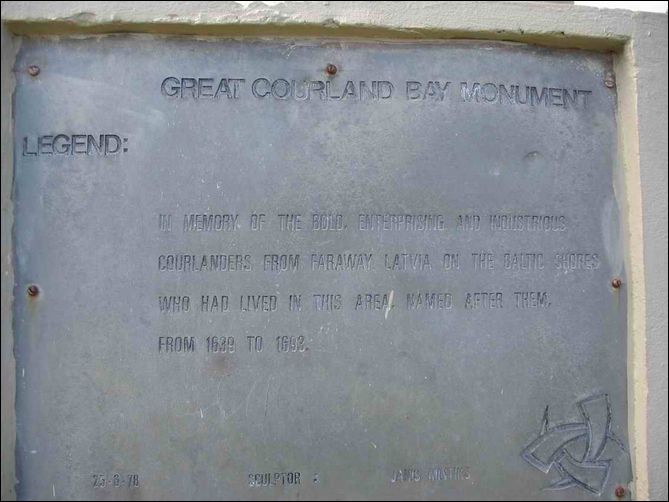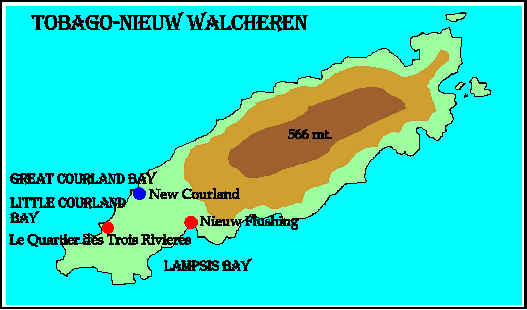A smallest state which ever had colonies – was Courland, today part of Latvia. Here is Honza Neugebauer’s text made on Erasmus in Riga:
Shortened process of colonization *wII
Under the rule of Duke Jakob Kettler (*1610, †1682) the Duchy established its first colony in Africa in 1651 at St. Andrews Island at the Gambia River and founded Jacob Fort there. The main export goods included ivory, gold, furs and spices. Soon afterwards, in 1652, Courlanders established another colony, in Tobago in the West Indies. There the main export goods included sugar, tobacco, coffee and spices.
However, during this time, the Duchy of Courland remained an object of interest for both Sweden and the Polish-Lithuanian Commonwealth. In 1655 the Swedish army entered the territory of the Duchy and the Swedish–Polish war (1655–60) had begun. The Swedish army captured Duke Jacob (1658–60). During this period, the Dutch took over both of Courland’s colonies, and the merchant fleet and factories suffered destruction. This war ended with the peace Treaty of Oliwa (1660). Courland regained Tobago on the basis of the treaty and held it until 1689. Duke Jacob set about restoring the fleet and factories, but the Duchy of Courland never again reached its pre-war level of prosperity.
Historical background of colonization
2.1 The state of the state
The Duchy of Courland and Semigallia started to exist in 1561 by splitting of Livonia confederation. It was a vassal state of the Grand Duchy of Lithuania from 1562 to 1569 and from 1569 to 1726 the Polish-Lithuanian Commonwealth.(at1)
Although nominally a vassal state, the dukes operated autonomously*wI. Courland was a prosperous and cultured German-speaking Duchy proud of its traditions and history*j. Strongest religions were Lutheranism and Roman Catholicism. Strong jewish comunity lived there (50-60% of the Jews living in Riga in the early 20th century had family roots in Courland*j.
Courland had a population of an estimated 200,000*t. It encompassed the areas of Courland and Semigallia, but several parts were joined later, f.e. Bishopric of Pilten was sold by Denmark in 1585. The capital was Mitau (Jelgava), important harbours on the coast of Baltic sea were Windau (Ventspils) and Libau (Liepāja) and bishopry was in Pilten (Piltene).
The advance of Duchy of Courland and Semigallia compared to bordering region was, that ongoing battles did not happen here – unlike the war between Polish-Lithuanian Commonwealth and Sweden happening in Riga region from 1600 to 1629. “For decades after the partition, the Baltic region remained an object of contention fof the region’s great powers…the main losers, of course, were the Baltic natives, who suffered from devastation wrought by war, hunger, and disease.”*c
2.2 Seamanship and Jacob Kettler
Kurlandian cities mostly were not part of hanza (like Riga), but they were in its sphere of trade and influence. Exceptional members of hanza were Windau (Ventspils; from 1314) and Goldingen (Kuldīga; from 1368).*wV
Wilhelm Kettler (second duke of Courland from 1587 to 1617) developed metalworking and shipyards in Piltene region. The new ships delivered the goods of Courland to other countries*wII. This was very important for the incoming development of seamanship during the reign of Jacob Kettler (1642–1682, son of Wilhelm).
During his travels in Western Europe, Jacob Kettler became the eager proponent of mercantilist ideas. Metalworking and ship building became much more developed, and powder mills began producing gunpowder. Trading relations developed not only with nearby countries, but also with Britain, France, the Netherlands and Portugal. Jacob established the merchant fleet of the Duchy of Courland, with its main harbours in Windau and Libau*wII.
These cities were the main harbours for all Polish-Lithuanian commonwealth. Yet, at least for a short period of time, Courland had owned one of the world’s largest merchant marines. Between 1660 and 1681 the Jakobskanal (Jacob’s Canal) connecting Mitau with the Dvina, was dug*h. Since 1638th until the end of the reign of James in 1682, 44 warships and 79 merchant ships were built in Windau shipyard.
Duke Jacob’s ambitions can be seen thgrough letter he wrote to the pope Inocent X., where he request his support for 3-4 million thalers to organize an expedition to the southern hemisphere, with the participation of 40 vessels with 24 thousand men.*wIV
Gambia *g16-18
3.1 Coming
In 1651 Duke Jakob decided to purchase the first property in West Africa and ordered Major Heinrich Fokam to lead this expedition. 3.9.1651, the ship “Walfisch” (The Whale) with 20 canoons left Windau. After a few months, followed by the sailing vessel “Crocodile” (crocodile).
“Walfish” reached the Gambia river mouth in october 25. After negotiation with local ruler of a tribe Kombo, they purchased the river island St.Andrew (now Kunta Kinteh Island) and Jillifree (now Juffure), a village on the north shore of the river. From the ruler of Barra a settlement Bayona (Bajonas) with the island St. Mary were also purchased. It is located in the mouth of the River Gambia in the Atlantic Ocean, a location of a nowday Gambian capital Banjul. They also purchased a part of land 60 miles east in the Gassan region. (at2)
They established trading settlements there, with the main stone fortress at St.Andrew isle. Though the English Crown had previously granted the island to two separate companies in 1588 and 1618. The fort named Fort Jacob after Jacob Kettler, the Duke of Courland, was used it as a trade base until 1659.
3.2 Trading
Heinrich Fock (Heinrihs Foks) was the first governor (1651 – 1654/5) and Otto Stiel (Oto Štīls) the second (1654/5 – 1661). First pastor was Gottschalk Ebeling, later joined by Joachim Dannenfeld They should concentrate more on the conversion of the pagans than on the souls of Courlanders. Thus they should learn the local language. *p
“Unlike other Europeans of the time, the Duke did not arbitraly claim the lands he settled by focing the natives off their homes. He rented his lands from the local chiefs and paid what he owed. He respected the local chiefants, and even trained and educated some of the Africans to be administrators for his colony”*g15
Slavery in Poland was forbidden in the 15th century and formally abolished in 1588 in Lithuania. Still, Courlandians actively participated in the slave trade. Slaves just were not captured near the colony. Roughly 900 slaves were taken annually to Tobago from 1654 to 1658 (cca 4500 totally).
The Courlanders brought salt, iron, brandy, glass and amber from Europe to trade for ivory, gold, hides, pepper, wax, indigo, coffee, ebony, spice, dyeing material and pearls. It was exported to Sweden, Poland and Russia. 18-20 expeditions involving 28-31 ships left Courland for Africa, althougt three expeditions did not make it to Gambia.
3.3 Leaving
Dutch protected Courlandians but they also occupied Jacob Fort and soon expelled Courlandians out in 1659. Than French pirate Du Quesne licensed by Sweds destroyed the colony. Gambian tribesmen drove the Dutch out off the fort by cutting off the water supply. Dutch left the island after wrecking anything left standing.
The Duke regained the colony for a short while. On March 6, 1661, a British expedition under Robert Homes landed there and demanded the fort, which the Courlanders just two days earlier had completed repairing the damage done during the Dutch occupation. Five British ships against four men and two women that remained alive was not a match, thus they left.
Duke Jakob tried to regain these territories. In November 1664, he signed a treaty with King Charles II of England saying in the first article that English receive St Andrew’s Island and everything on them. English confirmed Curonian right in the second article – but only for Tobago, which was in those time under control of Dutch and with no relation to England.*p
3.4 Remembering
Because of the the forecoming English bloody slavery trades centralised at St.Andrew, local tribes had to remember Courlandians in a better way.
The land leased from a tribe served for a settlement by Courlandians, would later become capital of Gambia.
Tobago*h,g18-24
4.1 Colonial background of Tobago (1498-1637)
Carribean tribes never stayed for long on Tobago. They lived on other islands, but not there.
Tobago was discovered by Cristoforo Colombo in 1498. The first colonizing attempt was made by Juan Rodriguez (ESP) in 1614 and lasted four months. Dutch colonization begun here at 1628 with 68 colonists. After more ships arriving in 1629 and 1632, about 200 colonists lived here. Spanish expedition destroyed the settlement and massacred the colonists on 1 January 1637.
4.2 Unsuccesfull attempts to establish a colony (1637-1647)
A few months later, in 1637, a Curonian ship with 212 colonists attempted to found a colony on the island but both this attempt and a subsequent one, in 1639, ended in failure.
Than the English colonists attempted to found a settlement on Tobago in 1639 but they were forced to withdraw in 1640. A renewed English attempt in 1642 met the same fate.
Two ships under Captain Caroon with about 300 Courlanders made a another attempt to colonize Tobago in 1642. Jesuit missionaries among the Carib quickly agitated and armed the tribes into attacking the settlement. They killed many Curonian colonizators and survivors evacuated to the Wild Coast (today’s Guyana, *t) or to Tortuga and later Jamaica (*wIII).
In 1647, a third English attempt to colonize Tobago also failed.
4.3 Tobago during Curonian colonization (1654-1659)
On May 20 1654, the ship “Das Wappen der Herzogin von Kurland” (The Arms of the Duchess of Courland) arrived carrying 45 cannons, 25 officers, 124 Courlander soldiers and 80 families of colonists to occupy Tobago. The settlers were of diverse ancestry – Germany, Scandinavia, England, France, others and mainly Dutch – they just had to recognize Duke’s authority.
Captain Willem Mollens declared the island “New Courland” (Neu-Kurland). A fort was erected on the south-west of the island, also called Fort Jacob (Fort James) with the surrounding town called Jacobsstadt (Jamestown). Other features were given Courland names such as Great Courland Bay, Jacobs (James) Bay, Courland Estate, Neu-Mitau (New Jelgava), Libau Bay and Little Courland Bay. An Evangelical Lutheran church was built by the Courlanders in their first year on the island.
In September 1654, a Zeelandian expedition under Pieter Becquart founded a settlement at Lampsins Bay on the opposite side of the island. This new settlement was named Nieuw Flushing. The Dutch built three forts here. The strongest was called Fort Lampsinsberg, the other two were Fort Beveren and Fort Bellavista. Thus the island was divided between the two nations.
Despite the close relationship between Courlandia and England, English pirates raided the island in 1655. Duke managed to take control of the island.
Shortly-lasting Tobago colony brought much wealth to 700 Courland colonists. African slaves were working hard at 120 plantations. Several sugar rafineries, two rum destilleries and an indigo factory were established exporting goods to Poland, Sweden and Russia.
Reinforcements from Courland arrived in 1657 and about 120 colonists were added. Meanwhile, the Dutch settlement had had a swift growth and in 1658 about 500 Frenchmen settled under Dutch sovereignty. They founded a settlement (named Le Quartier des Trois Rivières) in Little Courland Bay, not far from the Courlanders colony. By 1658, 1,200 men peopled the Dutch colony. (at3)
4.4 Permanent problems*g20-24
The Courlanders were in trouble for there was the Baltic war (from 1655) and no reinforcements came from Courland after 1657. Swedes overran Poland, and Duke Jakob was imprisoned in Riga from 1658 to july 1660. Duchy and fleet in Courland were nearly destroyed and an epidemy that killed almost one third of population broke out.*g22
“In 1658, the Dutch, who had been waiting for the right time to make the their move, convinced the governot of Tobago to send the Duke’s fleet home, because he needed their help back home in his dealings with Sweden.” Once the fleet left, the Dutch began to besiege the main fortress, Fort James and when it fell, they massacred a large number of setlers that were loyal to the Duke.*g20 On 11 December 1659, the Courlanders officially surrendered Tobago to the Dutch, and left Tobago in 1666 (Gambian St Andrew was taken over by English in March 6, 1661).*wIII
The Dutch colony flourished from 50’s until 1666, when they surrended to English. It counted about 1,500 colonists (prevalently Zeelanders and Frenchmen) and 7,000 slaves in 1660.*t
From 1666 untill 1693, British, Dutch and even French fought over Tobago. Thus the island was largely unoccupied in first half of 70’s.*g20,t
During 1667-1668, Duke formally tried to take back Tobago, but could not expel the Dutch, who claimed the island for their own.*g23 In December 1668 a Curonian ship made an attempt to occupy the old site of Fort Jacob but the Dutch were watchful and the Courlanders escaped.*wIII In July 1680, the Duke’s soldiers temporarily started colonizing the island again, but were attacked by the natives living on
Trinidad.*g23,w3
In 1681, the Duke tried to establish private colonizing company with union with English. Colony was neutral, even if Courland was involved in a war. Only Courlanders and English could settle here for a small fee and an oath of allegiance to the Duke.*g24 Because of much bigger English population and power, Courlanders that lived there in 80’s did not have any significant impact and slowly assimilated with other colonizators, joining the buccaneers or other Anglo-Dutch colonies.*wIII In May 1690, shortly after the island was sold by Courland the previous year, the Courlanders government permanently left Tobago. The last known mention of Courlander settlers at Tobago was in 1693, and English were firmly in control by 1699*g24
After
Jakob’s death in 1682, after ruling Courlandia for 43 years, nearly erased Courland’s small niche in world affairs. His son Frederic Casimir cared more for the luxurious living that for colonies.*g24
Courlanders are gone from their-former colonies. The Courland Bay on the west coast of Tobago remains as a reminiscence of their presence. The Courland Monument near Courland Bay commemorates the Duchy’s settlements (at4).*wIII Maybe some legends about the well-treating Curonians still survives around the mouth of Gambia river or in literature.
Eventhough this epoque is linked mainly with bloody slavery market, it can be also seen as an era of heroic attempts for both Latvians, Lithuanians and Poles (eventhought leaders were speaking German and 80% of colonizators were not from Courlandia). It is important to have some heroes.
sources:
Mainly Greger (“g”; at5) and wikipedia. Attached images are downloaded from wikipedia.
*b “Welcome to Encyclopædia Britannica’s Guide to History”.Britannica.com. 1910-01-31. Retrieved 2009-02-01. ( http://www.britannica.com/blackhistory/article-24160)
*c O’CONNOR, K.: Culture and customs of the Baltics states; Library of Congress, 1967; ISBN: 0-313-33125-1; page 14
*g GREGER, K.: “Too Rich for a Duke, too Poor for a King”; 1995; p 15-17
( http://www.google.cz/url?sa=t&rct=j&q=Gassan+gambia+courland&source=web&cd=2&ved=0CCcQFjAB&url=http%3A%2F%2Fminds.wisconsin.edu%2Fbitstream%2Fhandle%2F1793%2F30665%2FGreger.pdf%3Fsequence%3D1&ei=648GT6bDG4yZhQfwz9CqBg&usg=AFQjCNGhPOr6IF8oAb0hX8wblkbaxCtBJw )
*h World history on Korean Minjok Leadership Academy – Kourland ( http://www.zum.de/whkmla/region/eceurope/courland16411795.html )
*j http://www.jewishgen.org/courland/
*p KOŁODZIEJCZYK, D.: “CZY RZECZPOSPOLITA MIAŁA KOLONIE W AFRYCE I AMERYCE?” ( http://www.niniwa2.cba.pl/kolodziejczyk_kolonie_w_afryce.htm )
*t http://www.colonialvoyage.com/eng/america/tobago/dutch.html
division of eras inspired by: ARCHIBALD, D.: Tobago: melancholy isle, vol. I 1498-1771; Westindiana, 1987; ISBN 9768059001
*wI http://en.wikipedia.org/wiki/Courland
*wII http://en.wikipedia.org/wiki/Duchy_of_Courland_and_Semigallia
*wIII http://en.wikipedia.org/wiki/Courland_colonization_of_the_Americas
*wIV http://lv.wikipedia.org/wiki/Kurzemes_kolonijas
*wV http://en.wikipedia.org/wiki/Hanseatic_League





